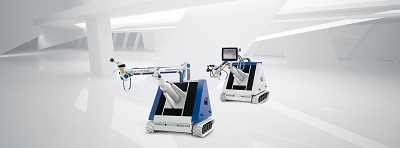
Using laser welding, fine seams with excellent surface quality and high strength can be fast carried out. The visible seams do not require any further finishing work, such as cleaning, polishing or sanding. In addition, material control of the energy input prevents possible cracking. Another advantage is the tightness of the welds (helium-tight).
With a 900 W laser large penetration depts of up to 6mm can be achieved, depending on the material and feed speed. This allows to weld even different types and thicknesses of material.
Another advantage: The laser introduces the heat very locally into the material, so that the heat affected zone remains small. This minimizes distortion and thus eliminates subsequent straightening of the component. The time and cost savings are significant because fixture construction is often superfluous.
Mobile laser welding
The mobile, flexible and programmable laser welding device ALFlak, from Alpha Laser allows working on large sheet metal parts as well as on small parts that are positioned on a worktable due to the unique arrangement of the movement-axes. Round seams are made with a rotation axis and sheets are fixed on a magnetic holder. Customer-specific adaptations can be realized easily due to the flexibility of the laser system.
But how is the handing? The machine is set up quickly and doesn’t have to be programmed – recurring welding tasks in series production can be rapidly taught in without any further CNC knowledge. Welding can be carried out either in pulsed or CW (continuous wave) mode. Depending on the welding task, the mode can also be changed within a program sequence. The process monitoring is done via a stereo-microscope and can be supplemented by camera observation during serial production.
The laser also opens completely new possibilities in the design of components. It makes many tasks in the first realizable. You can combine metal sheets, bridge gaps and weld joints and edges.
And what do the users say? Mathias Durau, Managing Director of Lasertechnik Kreiensen, is convinced of the technology. He was able to significantly expand his range of business by using a high-performance fiber laser. “Currently, our lasers are also used in mass production for the supply industry of a German car manufacturer. Due to the high degree of reproducibility and the high safety standard, the certification of the welding processes according to the VDA 6.3 standard was easily possible” says Durau.
Typical welding applications in sheet metal processing include seams and edge welds on housing parts, butt welds on pipes, welding short pipes to flat sheets, circular seams on turned parts and welds at plug-in points.
The advantages of laser welding are: Comparatively low investment and process costs, a high level of automation, flexible in use, as a rule, no fixture construction is required for small batch production, and process safe.
Alpha Laser offers its customers various mobile laser devices, open table systems and closed, laser-safe models. A detailed consultation on the implementation of laser safety and personal protective equipment is of course our standard.
Puma Rihanna













